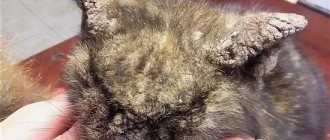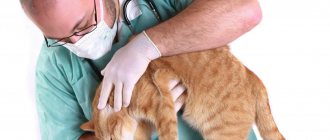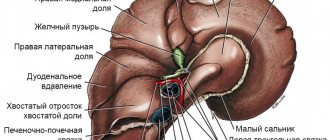Victoria Rashidovna Khazimulina
veterinarian Petstory
Liver diseases in cats are very dangerous. Cats are true carnivores, and the metabolism of proteins and fats is especially important for them. When the liver becomes inflamed, metabolic processes are disrupted, which disables other body systems. In addition, hepatitis is accompanied by cholecystitis. And due to the special structure of the excretory ducts of the gallbladder and pancreas, the disease can also affect the pancreas and duodenum, which will provoke a disease such as triaditis. In this article we will talk about an inflammatory disease, namely hepatitis in cats.
- Improper feeding
Hepatitis (hepatitis; hepat- + -itis) is inflammation of the liver. That is, liver diseases accompanied by an inflammatory process.
Causes of hepatitis
Causes of hepatitis in cats:
- Infections. Infectious hepatitis in cats develops as a complication of viral, fungal and bacterial infections (leptospirosis, panleukopenia, toxoplasmosis and chronic viral infections). Viral hepatitis does not exist as an independent disease in cats, unlike infectious adenoviral hepatitis in dogs.
- Autoimmune diseases.
- Toxins. Toxic hepatitis in cats can occur as a result of acute poisoning with poisons, chemicals, low-quality food (for example, if storage conditions are not met and the food is contaminated with fungal flora), medications, etc. All toxic substances that enter the animal’s body pass through the bloodstream through the liver, whose cells cleanse the blood of harmful components.
- Diseases accompanied by abnormal accumulation of copper in the liver.
- Due to the action of certain medications.
Prevention
It is impossible to protect a cat from hepatitis, but following the general rules of feeding and maintenance reduces the risks. You cannot feed your pet fatty, fried, salted and smoked foods, sweets - ice cream, cookies, yoghurt. It is important to treat your cat for parasites in a timely manner, vaccinate it, and prevent mice from being hunted where neighbors can poison them.
Moderate physical activity is indicated to prevent illness and relapse - overload and a sedentary lifestyle are harmful. Drafts, hypothermia and overheating should not be allowed. In old age, feline hepatitis can be prevented by regular preventive examinations.
Clinical symptoms of hepatitis
Symptoms of hepatitis in cats are nonspecific; not all symptoms may appear, since their presence depends on the stage of development of the inflammatory process in the liver:
- lethargy;
- loss of appetite;
- weight loss;
- vomit;
- increased urination and thirst (polydipsia/polyuria);
- icteric staining of the gums and other mucous membranes;
- accumulation of free fluid in the abdominal cavity (ascites);
- neurological symptoms due to increased concentrations of ammonia in the blood (hepatic encephalopathy).
Most often, two types of hepatitis occur in cats: cholangiohepatitis
(acute and chronic) and
lymphocytic portal hepatitis
.
Description
Hepatitis is an inflammatory liver disease.
As a result of pathological processes, healthy cells are replaced by connective tissue, which reduces the functionality of the organ. Among other tasks, the liver cleanses the blood of waste products and is involved in the metabolism of proteins, hormones, vitamins, and glucose. If the functioning of the organ is not restored, inhibition of these processes will lead to death. As in humans, feline hepatitis occurs in acute and chronic forms - both are equally dangerous. In the first case, death without treatment occurs within days, and chronic hepatitis in a cat can last for years. But without therapy, the result is the same.
Many owners worry whether cats suffer from hepatitis C and other viral forms. Fortunately, this is out of the question. Some viruses (calcivirus, plague, coronavirus) lead to inflammatory processes. But cats do not have viruses that directly infect the liver (as in people A, B, C...).
There is also no need to worry about whether hepatitis is transmitted to humans from cats. Other pets, children, even family members weakened by chronic illnesses are safe. However, personal hygiene rules still need to be observed, since inflammation is often accompanied by secondary infections (fungi, bacteria).
Cholangiohepatitis
Cholangiohepatitis is an inflammation of the liver and bile ducts.
The wide prevalence of cholangiohepatitis in cats is associated with the peculiarities of their anatomy: the pancreatic duct and the gallbladder ducts connect before emptying into the duodenum. Therefore, inflammation of the small intestine or pancreatitis (inflammation of the pancreas) also leads to inflammation of the bile ducts (cholangitis).
Cholangiohepatitis can manifest itself in acute and chronic forms.
The acute form occurs more often in young cats. It begins with a sudden refusal to feed and lethargy. Vomiting appears, body temperature often rises, and the abdominal area is painful. With acute hepatitis, dehydration quickly occurs. After this, the so-called “jaundice” or icterus (yellowish tint of the skin and mucous membranes), which is noticeable on the sclera of the eyes and gums. During this period, the activity of liver enzymes, bilirubin and the number of leukocytes in the animal’s blood increases.
The chronic form of cholangiohepatitis is more common than the acute form, and older cats are more prone to it. Symptoms with this course appear and disappear in periods, with periods of exacerbation often associated with stress.
Depending on the type of cells that are found during microscopy of liver samples, chronic cholangiohepatitis may have different names. If lymphocytes predominate, it is called lymphocytic cholangiohepatitis; if neutrophils - then neutrophilic; if other defense cells (macrophages, plasmacytes) – then granulomatous.
All forms of cholangiohepatitis can eventually lead to liver atrophy (cirrhosis).
The causes of acute cholangiohepatitis are often bacterial infections that pass to the liver from the small intestine (duodenum) and pancreas. In addition, acute cholangiohepatitis can be caused by coronavirus infection, intoxication, or feeding with low-quality or unbalanced feed.
Among the causes of chronic cholangiohepatitis, genetic predisposition comes first; it can also be due to an autoimmune disease, helminthiasis, cystoisosporosis, or malnutrition.
Symptoms
There are no specific symptoms of feline hepatitis - the disease develops with an increase in general malaise, signs of poisoning or infection. The chronic form proceeds for years without symptoms, without pain - there are no nerve endings in the liver. Acute conditions are accompanied by pain due to pancreatitis, inflammation of the gallbladder or ducts. Nonspecific symptoms:
| Symptom | Explanation |
| Jaundice | Due to the high level of bilirubin in the blood, the skin and mucous membranes acquire a yellowish tint. They check the eyelids, lips, gums, and the inside of the ears. |
| Temperature | As a rule, it is increased in infectious and decreased in toxic hepatitis. Low-grade feline hepatitis can develop without changes in temperature. |
| Vomit | With foam, bile, pieces of undigested food. |
| Diarrhea | Foul-smelling, foamy, discolored – gray or yellowish-gray in color. Sometimes diarrhea gives way to chronic constipation. |
| Dehydration | Check by gathering a fold of skin with your fingers. Release, hold for 10 seconds - when dehydrated, the skin clearly slowly returns to its normal position. |
| Decreased appetite | From “whims” to complete failure in acute intoxication. |
| Perversion of appetite | Products that the pet has not previously shown interest in. Gnawing whitewash from the walls. Licking the floor, eating litter, cleaning products. |
| Weight loss | Despite increased feeding, a cat with hepatitis loses weight to the point of anorexia. |
| Dark urine | Due to excess bile, urine turns tea-colored, sometimes with flakes, blood, and a greenish tint. |
| Bloated belly, flatulence | You can hear rumbling, the abdomen is enlarged, and upon palpation you can feel intestinal loops and gurgling. |
Symptoms of hepatitis in cats are accompanied by primary signs of poisoning, infection or another factor leading to inflammation. For example, many poisons make it difficult to breathe and depress the heart, allergies are accompanied by itching, and the side effects of taking medications are completely limitless. Therefore, the diagnosis is made on the basis of an in-depth examination, not relying only on symptoms and anamnesis.
Complications of hepatitis
- Hepatic lipidosis.
Cats do not tolerate periods of not eating well (anorexia). At this time, their liver often begins to store fat, which leads to lipidosis; the functional liver tissue is irreversibly replaced by fatty tissue. Cats with a lack of appetite due to cholangiohepatitis are at risk. - Hepatic encephalopathy.
Due to increased levels of ammonia and other unwanted components in the blood, brain damage occurs. - Portal hypertension
and the formation of free fluid in the abdominal cavity (ascites). - Sometimes chronic cholangiohepatitis progresses to cancer. In humans, there has been a proven connection between chronic stimulation of lymphocytes and the occurrence of malignant lymphoma. Therefore, it is likely that chronic lymphocytic cholangiohepatitis in cats can provoke lymphoma and malignant abnormalities of lymphocytes.
Features and causes of the disease
This disease in a cat can cause symptoms that are very similar to many other viruses. Therefore, it is important to show the cat to a good specialist who can competently conduct an examination and make a diagnosis. Improper treatment of this disease leads to a deterioration in the general condition of the cat’s body and the progression of hepatitis.
Hepatitis can be divided into two types depending on the reasons that led to the development of the disease in the cat:
- Toxic - occurs after severe poisoning of the body due to an overdose of drugs, under the influence of various poisons and chemicals. Since the liver filters out all dangerous substances, this greatly affects the functionality and health of this organ. If the poison penetrates the body for a long time, then therapy cannot give a positive result. Very often, hepatitis develops after treatment of helminths with toxic drugs. Therefore, timely prevention of parasites is one of the most important methods of preventing hepatitis. Helminths can also destroy the liver from the inside and affect it with the products of their vital activity, thereby provoking the development of the disease.
- Infectious – occurs as a result of diseases caused by viruses, fungi and bacteria. Most often, this type of hepatitis affects old and young cats that have not been vaccinated against diseases such as distemper, leptospirosis and enteritis. In this case, hepatitis is a complication, the symptoms of which complement the symptoms of the underlying disease.
It is worth noting that animal hepatitis does not pose any danger to humans. The course of this disease in humans differs in signs and symptoms from the disease in cats.
Diagnosis of hepatitis
- General clinical examination of the animal.
- General clinical and biochemical blood test. The presence of hepatitis or chronic inflammation of the intestines and pancreas is indicated by a high level of GGT, an increase in ALT and alkaline phosphatase with normal levels of thyroid hormones. The level of bilirubin and globulins also increases, cobalamin and folic acid decrease.
- Serological studies. Used for suspected viral infections (feline leukemia, feline immunodeficiency, feline viral peritonitis), as well as toxoplasmosis.
- X-ray examination.
- Ultrasound of the abdominal cavity (is important in diagnosing cholangiohepatitis or obstruction (blockage) of the bile duct).
- Liver biopsy. A needle is inserted through the abdominal wall into the animal's liver and material is collected for further research. The best way to diagnose hepatitis is by examining small pieces of the animal's liver. They are obtained by exploratory laparotomy (surgically) or by biopsy. Both procedures pose a certain risk and must be carried out with extreme caution, because in severe cases of the disease, the affected organs may bleed during puncture, and anesthesia poses a risk to the sick animal.
- Bacterial culture of liver and bile. If liver and bile samples can be obtained for pathological examination, it may be possible to test them for the presence of bacteria.
Prevention of hepatitis
You should definitely pay more attention to the prevention of liver disease. Care must be the most attentive: you must also ensure that the cat does not bite the poisonous plant again or pick up parasites. Deworming is carried out according to schedule, it is easy to study all the issues related to this process.
Vaccination should be carried out strictly on time and according to the recommendations of specialists.
We watch the video and take care of the health of our beloved kitty:
global $ads_google; //data-ad-slot=”2475549904″ $ads_google = empty($ads_google) ? false : true; ?> if ($ads_google == false) {?> $ads_google = true; ?> } ?>
Treatment
- stabilization of the body's condition in critical cases (intravenous therapy with electrolyte solutions). If necessary, artificial or parenteral nutrition and antiemetics are prescribed;
- antibiotics;
- choleretics and hydrocholeretics (substances that help the passage of bile from the liver to the intestines). They are prescribed to prevent bile stagnation, because this is one of the main phenomena of cholangiohepatitis;
- anti-inflammatory drugs;
- immunosuppressants (prescribed for lymphocytic portal hepatitis);
- vitamins K, E, B12. With cholangiohepatitis, the ability to absorb these vitamins through the intestines is reduced. In some cases, the use of taurine, folic acid and L-carnitine is also indicated.
Causes of the disease
Improper feeding
Errors in feeding, such as an unbalanced diet, an excess of difficult-to-digest components, the use of products not intended for animal feeding, spoiled foods - all this can cause inflammation of the liver.
Poisoning
A cat can accidentally ingest various toxins and poisons. Baits for rodents and other pests often attract pets. But even if the poisons do not smell like food, a pet can accidentally get dirty with household chemicals at home or on the street, and then, when licking its fur, become poisoned by them.
Infections and infestations
Viruses, bacteria, protozoa and helminths often cause hepatitis. Producing toxins during their vital activity, they poison the body, and the work of neutralization lies mainly with the liver.
Use of certain drugs
Anti-inflammatory drugs (GCS, NSAIDs) should be prescribed in individually selected dosages.
Not only drugs in this group can cause liver inflammation. There are some antibiotics, antiparasitic drugs, and even vitamins that are dangerous for cats under certain conditions. Therefore, before giving your cat medication, be sure to consult your veterinarian.
Autoimmune processes
The body can perceive its own cells and tissues as foreign and fight against them. Such diseases are rare compared to infections and poisonings, but they do occur.
Diet
The cat should be switched to a diet containing a reduced amount of sodium, carbohydrates and an increased amount of protein. It is not advisable to feed your animal food containing sucrose or fructose.
To avoid hepatic encephalopathy, if the level of ammonia in the blood of a particular animal is elevated, the amount of protein in its diet should be limited, because Protein is the main source of ammonia in the body.
It is very important to feed your cat small meals multiple times throughout the day.
Treatment and therapy
Treatment of this disease in cats begins with eliminating the accompanying disease, if any. After this, intoxication of the body is eliminated, drinking and eating habits are restored. On the first day of treatment, the cat is not fed, but only given a sufficient amount of water. On the second day, you can give your pet a low-fat broth made from meat or fish. Over time, when the cat begins to feel better, lean soups, porridges and soufflés are gradually added to his diet. The cat should get a minimum of carbohydrates and sodium from its food. Feeds that contain fructose and sucrose are contraindicated during this period. The animal should be given food in small portions, but often. You need to be very careful about the amount of protein in the diet of a sick cat, because its excessive consumption can provoke an increase in the level of ammonia in the body, which, in turn, causes hepatic encephalopathy. Treatment of hepatitis in a sick cat follows the use of special medications that provoke restoration of liver function to improve the body's resistance to viruses, bacteria, poisoning and worms.
For hepatitis in cats, your veterinarian may prescribe the following medications:
- vitamins E, B12, K;
- antibiotics;
- immunosuppressants;
- hydrocholeretics or choleretics, which prevent stagnation of bile in the body;
- drugs that stop the inflammatory process.
It is worth noting that the acute form of hepatitis is much easier to treat than the chronic form. Long-term liver damage usually leads to irreparable consequences, but the owner may not notice the disease. In this situation, any disruption of the immune system or stress aggravates the cat’s condition and the inflammatory process covers several systems of his body, which can provoke the death of the animal. Therefore, the disease cannot be brought to its extreme stages; treatment must be started as early as possible.
Prognosis for hepatitis in cats
The liver is an organ that recovers well in the event of a sudden crisis, provided that some of its cells (hepatocytes) remain intact. Therefore, a cat with an acute form of hepatitis is not difficult to cure. However, with chronic hepatitis the situation is different. Diet and proper treatment help improve the animal’s condition, although the chronic form of the disease is not completely cured. The animal can live a normal life if the conditions of detention and therapeutic feeding are observed, although the disease can worsen with any stress.
The prognosis is less favorable for cats with advanced stages of hepatitis, when many systems are susceptible to inflammation and the disease has approached the early stages of leukemia (lymphoma).
(c) Veterinary center for the treatment and rehabilitation of animals “Zoostatus”. Varshavskoe highway, 125 building 1. tel.
8 (499) 372-27-37
Treatment of hepatitis in cats
global $ads_google; //data-ad-slot=”2475549904″ $ads_google = empty($ads_google) ? false : true; ?> if ($ads_google == false) {?>
$ads_google = true; ?> } ?>
It is useless to fight the symptoms of hepatitis when you need to remove the cause. This will be the first step in an effective course of treatment.
Next, a strict diet is selected: you must not overstrain the tormented liver.
Medicines prescribed by a veterinarian must be given to the animal according to the course prescribed by the doctor and according to the treatment regimen. Hepatitis is treated:
- B vitamins;
- Essentiale;
- antispasmodics (drotaverine, no-spa);
- neomycin or penicillin (other antibiotics may be prescribed);
- intravenous infusion of saline solution containing glucose and vitamin C, which will prevent dehydration and stop intoxication;
- antihistamines (if allergic reactions occur).
Diet
Possible acute damage to the gastrointestinal tract with vomiting and diarrhea. It is advisable to deprive the pussy of feeding for a day or two. But water should always be nearby, clean and fresh. An electrolyte solution with glucose works well.
A cat's diet has an extremely important influence on the course of the disease and its outcome.
It is important to create a diet that will promote recovery. The first day after diagnosis, therapeutic fasting is indicated, and it is easy for the cat, he doesn’t want to eat anyway. The next day, low-fat broth with beef meat is given in small quantities.
Neither fish nor poultry meat can be given yet.
On the third day, boil rice or oatmeal, but also in small quantities. Pate is added to an exhausted cat. For the next two days, the food is prepared with milk and given yogurt or a little low-fat cottage cheese.
On the sixth and seventh days of the diet, you can give the cat vegetables mixed with yogurt.
Hepatitis C is a viral disease that often affects young people, but in recent years there has been an increase in the number of nosologies in older people. Statistics describe more than 170 million of the world's population infected with chronic hepatitis C. Every year there are about 3 million cases of sick people. The uneven spread of the disease in many countries is due to various factors. Attempts by medical experts to permanently eliminate the disease from the world end in failure, despite the possibility of completely curing the pathology in humans.
Hepatitis C – hepatitis C is transmitted by parenteral and hematogenous routes. The infection most often spreads through the blood. A minimal number of cases occur through sexual transmission (about 3%).
Drug addiction is becoming the main reason for the persistence of the pathogen in the human population. When using a shared needle, the likelihood of a person getting sick significantly increases. Infection is also caused by weakened immunity in people who abuse drugs. The danger of viral hepatitis cannot be ignored, despite the fact that representatives of the flavivirus family can be completely destroyed, but the main thing is to detect the disease in a timely manner.
The main route of transmission of hepatitis C is hematogenous.
To infect a person, it only takes a small amount of infected blood. One injection with a contaminated needle, even without the presence of liquid contents, is enough to infect a person.
There are cases of infection after tattooing on the body. The disease is transmitted with the help of dirty instruments that were used during manipulations on the body of a person who is a carrier or a patient.
Household transmission of the disease is possible through the use of razors, brushes, and shared tools. If there is a person in the family with hepatitis C, careful hygiene and the use of individual personal hygiene devices are required. The hepatitis C virus is not as contagious as the variant with liver inflammation provoked by the pathogen of group B. During operations and injuries with the introduction of the pathogen by non-sterile instruments, infection is possible, but treatment should be carried out in the initial stages in order to completely get rid of hepatitis C. This approach cannot be used when infected with the hepatitis B virus.
There is evidence of infection transmission of the pathogen through insect bites. Mosquitoes and flies, theoretically, can bite an infected person and transmit the infection to a healthy person. Scientists reject this possibility, since in the gastrointestinal tract of an insect, blood cells are destroyed by enzymes, but viruses are quite small in size and can be resistant to external influences of aggressive compounds.
A few viruses are enough to transmit through blood. When they enter the body, they enter the cell, where they multiply by incorporating their own RNA molecule into the genetic apparatus.
It should be noted that most people become infected due to failure to comply with basic personal hygiene rules. Even through an ordinary toothbrush, transmission of the pathogen is possible if it was used by a person with viral hepatitis. Basic rules cannot be ignored, as they prevent life-threatening diseases.
In civilized countries, routes of transmission of hepatitis C through donor blood and unsterile instruments in surgery are much less common than in third world countries. Individual human characteristics do not allow us to completely eliminate the disease throughout the world.
All modes of transmission of hepatitis C
Sexual transmission of hepatitis C is much less common (no more than 3%). Some scientists claim that this method of infection does not exist, but there are practical examples of a person becoming infected after sexual relations with a sick person. The possibility of ignoring the sexual route of infection is due to the presence of an incubation period for the disease lasting 2-3 weeks. There are no acute symptoms immediately after an unprotected relationship, so experts rule out sexual transmission of the disease. During incubation, some temporary signs of local infection are possible - burning of the genitals, bleeding. Women attribute such symptoms to thrush (candidiasis). You can stay safe by using condoms, but experts only guarantee 95% prevention of infection. There are microdefects due to poor quality manufacturing of these protective equipment. Due to its small size, the hepatitis C virus is able to penetrate even small defects. Clinical studies confirm the likelihood of sexual transmission with a high viral load, but they do not exceed 4%. Unprotected sexual intercourse and damaged mucous membranes are factors that increase the risk of viral infection. Even one ulcer or erosion of the genital organs cannot be ignored, since through them the pathogen can easily penetrate into the body. There is information regarding the transmission of the pathogen during sexual relations in individuals with a predominant monogamous type of relationship. Infection increases among people who have multiple contacts. There are no statistics regarding the transmission of hepatitis C through oral contact. Spanish researchers conducted clinical studies that confirmed an increase in the number of sexually transmitted hepatitis C infections with an increase in the number of extramarital partners.
For hepatitis C, airborne transmission is not relevant . Airborne infection does not occur. When a person with hepatitis sneezes or coughs, the pathogen is not released into the environment, so infection of surrounding people is excluded. A similar situation can be observed with handshakes. In the absence of direct contact between the blood of a sick and healthy person, infection does not occur. Kitchen utensils are not a source of hepatitis infection. Even if droplets of the blood of an infected person get on it when eating food from this dish, any particles, including viral ones, are processed by enzymes of the gastrointestinal tract.
Domestic infection is theoretically possible , but only if particles of the blood of an infected person get on an abrasion, cut, erosion, or wound defect.
Despite recent publications regarding the likelihood of a complete cure for this disease, according to scientists, only 10% achieve complete elimination of the pathogen with long-term complex treatment. In other cases, a chronic course occurs with gradual damage to the liver tissue. A dangerous consequence of chronicity is liver cirrhosis. The nosology is caused by the growth of coarse fibrous tissue at the site of damaged areas of the organ. A lack of hepatocytes leads to liver failure.
To prevent widespread infection, isolation of patients is required, but modern democratic aspects do not even allow limiting the social activity of such patients. No special living conditions have been created for such patients, and low moral qualities in these patients often become the reason for the appearance of hepatitis C in close people during unprotected sexual intercourse or everyday proximity. In fairness, it should be noted that most people are carriers of the hepatitis C virus. They do not develop an active form of the disease. Your own immunity against the pathogen is not formed, so at any time if the protective forces are weakened, liver damage is possible. The reasons for carriage are not scientifically explained, but it is believed that the source of resistance to pathology in humans is a hereditary predisposition to the formation of certain types of antibodies against the pathogen.
What kind of hepatitis is transmitted through saliva?
Certain viruses are transmitted through saliva. This route of transmission is possible for viruses A and B, but you need to be careful about the presence of other risk factors that may cause transmission through saliva. For the pathogen to penetrate into the blood, damage to the mucous membranes and skin is required. For a pathogen to enter the blood of a healthy person from an infected person or carrier, bleeding from the gums and other parts of the oral cavity is required. The exchange of infected blood is possible through oral contact.
How is hepatitis C transmitted through kissing?
When kissing, hepatitis C can be transmitted through saliva. The exchange of various fluids during French kissing can become a source of pathogen entry into the blood. Oral contact also becomes a source of disease transmission through saliva. To minimize infection, the number of casual and unprotected sexual relations should be limited. Carriers of the disease are often people with low social qualities. Barrier contraceptives can protect against the transmission of hepatitis C, but it is difficult to draw a conclusion about the degree of protection.
Is hepatitis C transmitted from father to child?
Hepatitis C is not transmitted from father to child. Only through household or contact infection is infection possible. Cases of transmission of viral liver inflammation from mother to child are more common. When passing through the birth canal, blood particles containing the virus may enter the baby's body. Such infection cannot be prevented by existing means. The child can receive resistance from the father due to the transfer of immunity factors. The lack of treatment protocols for newborns leads to gradual chronicity of the infection.
In conclusion, we list the main routes of transmission of the disease:
- Tattooing and piercing - with poor quality sterilization of instruments;
- Blood transfusion from a patient or carrier;
- Dental treatment with non-sterile instruments;
- Sharing syringes;
- Using toothbrushes and razors from a sick person;
- Infection from a sick mother (hepatitis is not transmitted from the father);
- Sexual method in the absence of barrier protection methods.
Doctor - valeologist
4th City Clinical Hospital named after N.E. Savchenko Chernov V.A.
WHO information was used in preparation.











